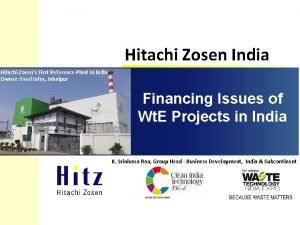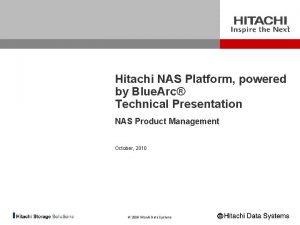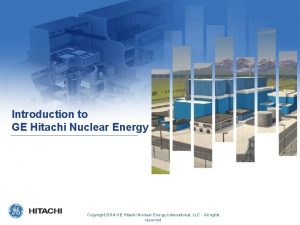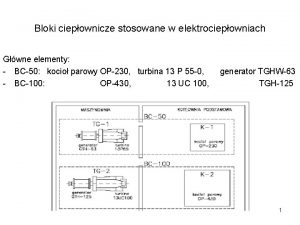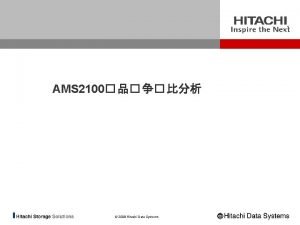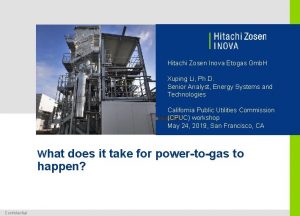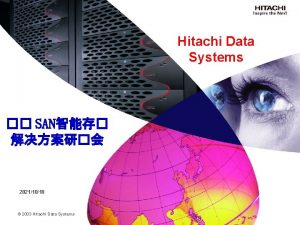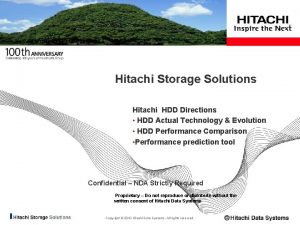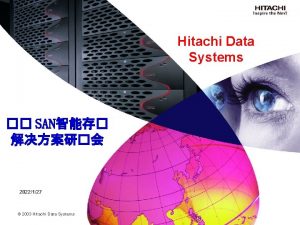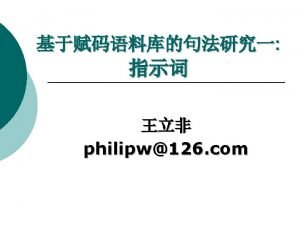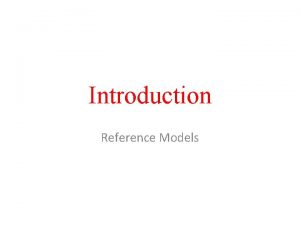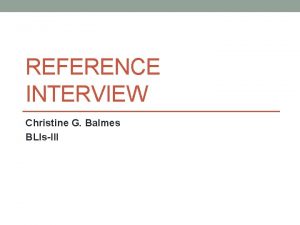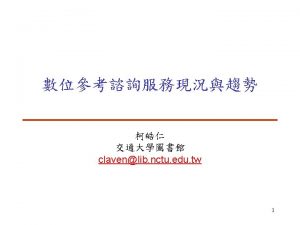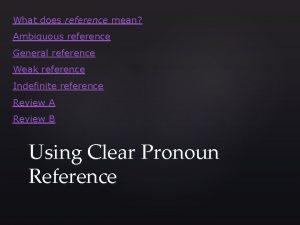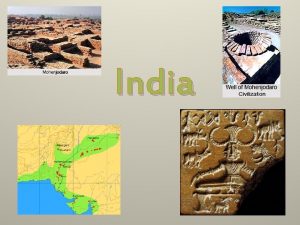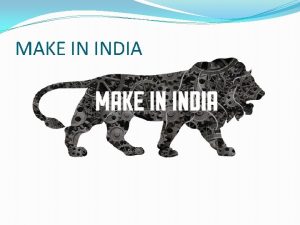Hitachi Zosen India Hitachi Zosens First Reference Plant
















- Slides: 16

Hitachi Zosen India Hitachi Zosen’s First Reference Plant in India Owner: Essel Infra, Jabalpur Financing Issues of Wt. E Projects in India K. Srinivasa Rao, Group Head - Business Development, India & Subcontinent

Hitachi Zosen Corporation-Company outline Date of Founding April 1, 1881 (136 years Ago) President Takashi Tanisho Number of employees 10, 300(As of September 30, 2017) Capital 45, 442 million JPY (≒ 403 million USD) Net sales 399, 331 million JPY (≒ 3. 5 billion USD) (Consolidated) ※Environmental & Industrial Plants Domain : 63. 8% Waste Treatment Systems Tunneling Boring Machines Bridges Pressure Vessels 2

History of our environmental business E. H. Hunter of UK founded Osaka Iron Works (=Hitz) in Japan (Osaka) 8, 000 Hrs Continuous Operation Our 1 st Wt. E plant in TAIWAN (Taipei ) 450 t/d x 4, 48 MW 1 st Wt. E plant in KOREA (Seoul) MSW Incineration System Technology License Introduction from Von. Roll 1881 ‘ 1939 Our 1 st Waste treatment plant by Von Roll (Dordrecht, Netherlands) ‘ 60 ‘ 65 1 st Wt. E plant (with STG) in Japan (Osaka city) 200 t/d x 2, 5. 4 MW ‘ 87 ‘ 97 ‘ 09 AE&E Inova (=Von Roll) Hitachi Zosen Inova AG (Zurich, Switzerland) Hitachi Zosen India Pvt Ltd was established(100% subsidiary) HZ India is qualified in Various Municipal Corporation including SDMC and in the process of finalising 4 Contracts this FY. ‘ 10 ‘ 11 ‘ 16 ‘ 18 Our 1 st Wt. E plant in CHINA (Chengdu) 400 t/d x 3, 24 MWd Latest Wt. E plant in UK (London) 763 t/d x 3, 65 MWd First HZ India Wt. E Plant in Jabalpur. India. Note: Wt. E = Waste to Energy STG = Steam Turbine Generator 3

References (all over the world) 886 Europe 213 Africa 3 Copyright Hitachi Zosen Corp. Asia 587 Oceania 3 (as of April, 2017) North America 79 South America 1 4

HZC-References (Asia) 8 Plants in Korea 486 Plants in Japan 77 Plants in China (13 Plants by Hitachi Zosen Group & 64 Plants by Licensees) 1 Plant in India 4 Plants in Others 587 Plants (as of April, 2017) 2 Plants in Thailand 7 Plants in Taiwan 1 Plant in Vietnam 1 Plant in Malaysia 5

Relevance of Wt. E In India Increasing Dumpsites everyday Nation’s focus on Swach Bharat and renewable energy Wt. E viewed as compatible with recycling Wt. E Combustion technology has +100 year proven track record Public opinion of Wt. E is improving globally Increase in GDP makes more generation of solid waste Urbanization & Cities becoming denser than yester years Paucity of space for further dumping and hence volume reduction through W t E is essential Not having enough fossil reserves Mandatory Compliance with SWM Rules 2016 by ULBs 6

Reality of Present Wt. E projects Funding Financial closure of many Wt. E projects are taking too long time more than Two years. The projects whose concession agreements have been closed two years back, still not achieved Financial closure. ULB’s role in the financial closure of a particular project is almost Zero. ULB feels always their responsibility is closed once the land MSW is allotted to a successful Developer bidder. The concept of PPP appears to be not very effective in a country where policy framework is not properly defined. 7

Issues affecting Bankability of Wt. E Projects No stable uniform tariff policy which often changes from state to state. Exaggerated concerns on Dioxins and Furans by NGO’s despite Wt. E meets the stringent norms of European Emission Directive 2000/76/EC and SWM 2016 Rules. No Soft financing available Policy for tipping fee/ Gate fee / Grant / Viability Gap Funding (VGF) is not in place and there is no standard benchmark. Policy changes too fast and is not held sacrosanct from time of tendering to time of execution of a Project 8

Issues affecting Bankability of Wt. E Projects Not many bankers are keen to fund Wt. E projects SBI appears to be a bit active in funding Wt. E projects Still banks have conservative approach in financing Wt. E. Banks are considering to look at strong promoters whose balance sheets are very strong and not on the derived social benefits of Wt. E. Many bankers are insisting more than 30% collateral securities from the developers of the projects in addition to the other conventional securities of the project. 9

Key Challenges for Wt. E Cost of Wt. E plant construction also includes cost of Sanitary landfill for disposal of residues. It does not apply for other Renewable Energy Projects. Curious developers offers royalty to the ULBs and cause road blocks to successful MSW management. No single project has taken shape which offered royalty to ULBs. Change of council, administrator/commissioner or even Executive Engineer of ULBs could cause hiccups even for existing agreements and tendering process. 10

Risks of PPP projects Concession Agreements must be even with a risk sharing mechanism between the ULB and the developer Majority of the Concession Agreement terms in India heavily favor the ULB Draft Model Concession Agreement should be developed specific to Wt. E. Bankability of PPP Projects in Wt. E must be examined before the inviting the tender. This is not happening. 11

Traditional requirements of Banks for funding First charge on all the present and future immovable and movable Assets of the borrower. First charge on intangible assets of the Borrower including but not limited to goodwill, and intellectual property rights. First charge on all current assets of the Borrower ranking pari-passu with working capital lenders. A first charge on the Trust & Retention Account, Debt Service Reverse Account and other services and any other bank accounts of the Borrower wherever maintained. 12

Traditional requirements of Banks for funding A first charge by way of assignment or creation of security interest of – All the rights title, interest, benefits, claims and demands of the Company in the Project Documents such as the concession Agreement, EPC/ Construction contracts. O&M related agreements, land lease Agreements, supply Contracts, Service Contracts, etc. , – All the rights, title, interest, benefits, claims and demands of the Company in the permits, approvals and clearances pertaining to the project. – All the rights, title, interest, benefits, claims and demands of the company in letter of credit, guarantee, performance bond corporate guarantee bank guarantee provided by any party to the project Documents and All insurance contracts / insurance proceeds. 13

Traditional requirements of Banks for funding Collateral – Pledge of 100% shares of the promoters in the company in favour of participating lenders. – Personal Guarantee of the Promoters Directors. – The aforesaid security will rank pari-passu in favour of the participating consortium banks / Financial Institutions. Despite our clients are prepared to accept such stringent conditions of the lenders/bankers, they are not achieving the financial closure in pre-agreed time frame. 14

Conclusions SWM is a Public Utility Activity. Community’s willingness to PAY for improved services of SWM is focal point for its success. Improved services entail “ Gate Fee/ Tipping Fee” for the service provider. Urban Local Bodies have WTE as the only option in future in view of the constraints for land. Royalty and Zero Waste concepts in SWM are far away from reality and not sustainable. Adequate technical criteria to be prescribed for participating in the tender process to invite serious bidders as SWM is a specialized activity Waste to Energy Projects should not be developed on the basis of “ Tariff Based Bidding Process”. In stead , the projects should be based on “ Tipping fee” based bidding. Capacity building up in this area is highly critical. Hitachi Zosen continues to contribute for this sector 15

Thank You 16
 Hitachi zosen india
Hitachi zosen india Hitachi vantara oil and gas
Hitachi vantara oil and gas Bluearc nas
Bluearc nas Solutionary
Solutionary Hitachi young leaders initiative
Hitachi young leaders initiative Ge-hitachi
Ge-hitachi Hitachi 8500
Hitachi 8500 Ge-hitachi
Ge-hitachi Tst
Tst Hitachi
Hitachi 2100-2008
2100-2008 Reference node and non reference node
Reference node and non reference node Reference node and non reference node
Reference node and non reference node India plant quarantine
India plant quarantine Intraspecific hybridization
Intraspecific hybridization Taichum
Taichum Plant introduction in plant breeding
Plant introduction in plant breeding
